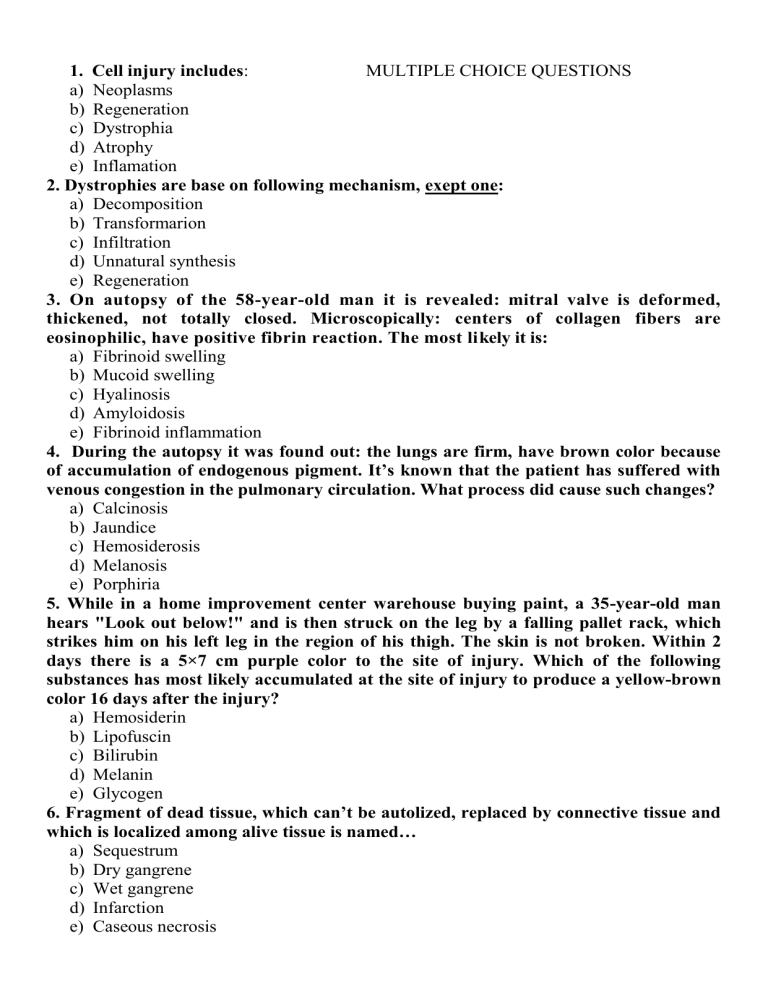
1. Cell injury includes: MULTIPLE CHOICE QUESTIONS a) Neoplasms b) Regeneration c) Dystrophia d) Atrophy e) Inflamation 2. Dystrophies are base on following mechanism, exept one: a) Decomposition b) Transformarion c) Infiltration d) Unnatural synthesis e) Regeneration 3. On autopsy of the 58-year-old man it is revealed: mitral valve is deformed, thickened, not totally closed. Microscopically: centers of collagen fibers are eosinophilic, have positive fibrin reaction. The most likely it is: a) Fibrinoid swelling b) Mucoid swelling c) Hyalinosis d) Amyloidosis e) Fibrinoid inflammation 4. During the autopsy it was found out: the lungs are firm, have brown color because of accumulation of endogenous pigment. It’s known that the patient has suffered with venous congestion in the pulmonary circulation. What process did cause such changes? a) Calcinosis b) Jaundice c) Hemosiderosis d) Melanosis e) Porphiria 5. While in a home improvement center warehouse buying paint, a 35-year-old man hears "Look out below!" and is then struck on the leg by a falling pallet rack, which strikes him on his left leg in the region of his thigh. The skin is not broken. Within 2 days there is a 5×7 cm purple color to the site of injury. Which of the following substances has most likely accumulated at the site of injury to produce a yellow-brown color 16 days after the injury? a) Hemosiderin b) Lipofuscin c) Bilirubin d) Melanin e) Glycogen 6. Fragment of dead tissue, which can’t be autolized, replaced by connective tissue and which is localized among alive tissue is named… a) Sequestrum b) Dry gangrene c) Wet gangrene d) Infarction e) Caseous necrosis 7. The examples of internal bleeding are, exept one : a) Hemothorax b) Hemopericardium c) Hemoperitoneum d) Hematocele e) Pneumorrhagia 8. The physiological active hyperemia can be a) Collateral b) Angioneurotic c) Inflammatory d) Work e) After anemia 9. A 45-year-old woman who has been bedridden for several weeks has the onset of left sided chest pain along with dyspnea. She has some tenderness in her left leg, which has a slightly greater circumference in the thigh than the right. A ventilation/perfusion scan shows evidence for a left lower lobe perfusion defect. Which of the following vascular diseases is most likely to cause these findings: a) Phlebothrombosis b) Hyaline arteriolosclerosis c) Monckeberg's medial calcific sclerosis d) Complex calcified coronary atherosclerosis e) Arterial mural thrombosis 10. A 65-years-old patient suffered by thrombophlebitis of the deep veins of both legs has died suddenly. Autopsy was showed free lying dry friable red masses with a dull crimped surface within the truncus pulmonalis and bifurcation of the lung artery. What process within the vessels did pathologist find? a) Thromboembolism b) Thrombosis c) Tissue embolism d) Postmortem clot e) Hemangioma 11. The 43-year-old patient was hospitalized 22 days ago in pulmonological department because of two-sided bronchopneumonia. The patient has died. During autopsy the round-formed cavity in diameter of 3,5 сm with clear borders filled with greenishyellowish color fluid was found in the left lung. About what type of inflammation can we talk in this case? a) Exudative purulent inflammation b) Exudative serous inflammation c) Exudative fibrinous inflammation d) Exudative hemorrhagic inflammation 12. A patient with burn disease died due to progressive septicaemia. The autopsy in the anterior abdominal wall by means of microscopic examination revealed diffuse infiltration of intermuscular spaces by segmentonuclear leukocytes, tissues edema and lysis of muscular fibres. Determine the nature of the pathological process. a) Phlegmon b) Necrosis c) Diphtheritic inflammation d) Catarrhal inflammation e) Abscess 13. A 46 year-old man complains of difficult nose breathing. Mikulich cells, storage of epithelioid cells, plasmocytes, lymphocytes, hyaline balls are discovered in the biopsy material of the nose thickening. What is the most likely diagnosis? a) Meningococcal nasopharyngitis b) Rhinovirus infection c) Scleroma d) Allergic rhinitis e) Virus rhinitis 14. A patient was admitted in the hospital with diagnosis of trichinellosis. What kind of inflammation develops within the muscles around the parasites? a) Exudative fibrinous b) Exudative purulent c) Exudative serous d) Proliferative granulematous e) Proliferative interstitial 15. A 22-years-old patient was admitted in hospital with complaints on heavy nasal breathing. During the examination of nasal cavity it was found the thickened mucous membrane, a lot of mucus and nodular infiltrates without erosions. It was diagnosed as rhinoscleroma of nose. It was took the biopsy. What typical morphological changes may be found? a) Granulomas with Mikulicz’s cells b) Granulomas with Virchow’s cells c) Granulomas with Langhan’s cells d) Granulomas with foreign body cells e) Interstitial inflammation 16) What morphogenetic mechanisms of the development of dystrophias are you know? a)……………. b)…………… c)…………… d)…………… 17) List of the proteinaceous stroma-vascular dystrophies: a) ………. c)……….. b) ……… d)……….. 18) What stages of necrosis are you know? a) ……….. c)……….. b) ……….. d)……….. 19) The possible favourable fate of thrombi are: a) …….. b) ……. c) ……. d) …… 20) What forms of ehinococcosis are you know? a) ……… b) ……..






